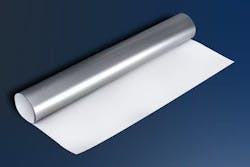Gone are the days of designing a system exclusively around traditional, flat, and rigid optical shapes. Advances in optical coatings and coating processes enable optical design engineers to test the limits of coated, curved, and unusual shapes within their applications. Find out more about the different materials that can be coated and the manufacturing challenges.
Roll-to-roll processes present a number of challenges when coating flexible surfaces, one of the challenges is stress. Balancing the stress between the two sides of the substrate and stress build up from many layers. This stress concern limits the thickness and complexity of the coatings achievable. To address this challenge, DSI utilizes their MicroDyn® batch coating technology. Using their MicroDyn® magnetron sputtering batch process, DSI can create complex coatings as thick as 10 µm, composed of hundreds of layers.
DSI FLEXIBLE COATING ADVANTAGES
- Expanded choices in coating materials and substrates
- Thicker coatings
- Increased layer count
- High durability
- More complex coatings
- Substrate alteration and optimization
DSI FLEXIBLE COATING APPLICATIONS
- Sunshade Thermal Control Film for Protection of Satellite Communication Equipment
- Metallization
- Semiconductor multilayers
- Oxide and Nitride multilayers
- Patterned coatings
DSI FLEXIBLE COATING CAPABILITIES
- Plasma substrate pre-treatment for contamination removal and surface optimization
- Materials (examples, others are possible)
- Metals (Al, Cr, Ag, Au)
- Semiconductors (Si, Ge)
- Oxides (SiO2, Nb2O5, Y2O3, TiO2, ZrO2, HfO2)
- Nitrides (Si3N4, AlN, TiN)
- Substrates (examples, others are possible)
- PET (Mylar, Hostaphan®, Melinex®)
- Polyimide (Kapton®, Upilex®)
- Fluoropolymers (Halar®)
- Polyetherimide (Ultem®)
- Polymethylmethacrylate (PMMA, Plexiglas®, Europlex®)
- Polycarbonate (Lexan®, Makrofol®)
- Polyethylene
- Patterning
THE DSI DIFFERENCE
DSI’s patented MicroDyn batch coating technology is a unique web coating process. Using the MicroDyn process, DSI can create complex coatings using a wide range of materials on a broad selection of substrates. The company’s unique innovations for coating flexible substrates enable higher performing thicker coatings, increased layer count, higher durability, and optimization.
TECHNICAL INFORMATION
DSI’s extensive experience in developing coating methods for flexible coatings has led to a number of industry-leading innovations.
MICRODYN
MicroDyn utilizes a proprietary magnetron sputtering chamber that was custom designed to address the challenges of high throughput coating. Rapid drum rotation and secondary-activation plasma source allow for lower process temperature and more complete reaction of oxides and nitrides. Furthermore, the MicroDyn Batch process is not restricted by the line speed limitations and multi-pass transits associated with roll-to-roll systems—it can deposit hundreds of layers just as easily as a single layer.
An additional benefit of MicroDyn is that it balances coating stress on both sides of the substrate, which aids handling and increases durability. Furthermore, because the substrate is statically mounted to a rotating drum for the entire deposition process, the front surface never touches a roller. As an additional form of surface protection, DSI has developed a “picture frame” method to hold a substrate in place during coating. This support system eliminates all surface contact on both sides of the substrate and prevents coating damage associated with storing materials in roll form, during which the coated surface contacts the “back surface” of the material.
SURFACE PRE-TREATMENT
DSI can perform longer duration or more aggressive plasma pre-treatment before deposition. This treatment can modify the substrate surface by removal of surface contaminants, microscopic mechanical alteration, or even chemical changes. Substrate surface modification can alter thermal stability, optical, or dielectric properties as desired.
